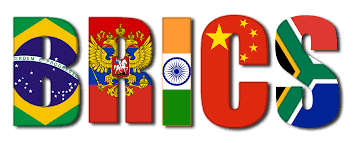BRICS, Explained

About BRICS
BRICS is the abbreviation of the “emerging market economies” i.e.- Brazil, Russia, India, China and South Africa. In past few years the BRICS group has become a major player in the global economic arena. The OECD predicted that China will become world’s largest economy over next 50 years, replacing the United States, and India’s GDP will surpass US. Largest Economies of two continents Africa and South America also present in it. The motive for BRICS countries to farm a partnership derives from their shared quest for economic and social development and for access a new markets.
History
Acronym BRIC was first used in 2001 by Goldman Sachs “The world needs better economic BRICS.” First formal summit of BRIC nations was commenced in 2009 in Yekaterinburg (Russia). Initially there were four member countries but in New York on 21 September 2010 BRIC foreign ministers agreed that “South Africa” may be invited to join BRIC. Accordingly on 14th April, 2011 in Sanya (China) South Africa joined the BRIC.
What can be potentials of BRICS
The BRICS countries now accounts for 19% of world GDP and 61% of overall global growth. So cooperation serves not only the common interests of BRICS members but also the global economy at large.
BRICS puts development high on agenda, with the goal of common development. Cooperation between member countries has increased in recent years covering a wide range of fields, such as trade, banking, taxation, customs, public health, science and technology, agriculture and culture.
BRICS nations are also member of a large economic group G-20, which is major forum for discussing economic issues and striving for economic reforms, and creating a more democratic and equitable system.
The size of BRICS economies, their economic potential and their demand for a stronger political voice on the international platform provides them central position.
What can be obstacles
The biggest problem is economic dominance of China. Not only China is economically large as the other members combined, it is the largest trading partner of almost all of them. In contrast remaining BRICS nations have minimal economic relations with each others.
The foreign policy relations among these countries is not always good and at times serious lacking trust. The most obvious divide is between India-China and Russia-China. Thus divergence do occur sometimes on certain political and trade issues.
The BRICS members are regional to the point they have little contact with each other. Therefore, the struggle to come up with substantive agenda.
Their capabilities also lagged behind in international rule making and decision making while BRICS is making difference in various areas it still needs time.
Outcomes of Goa Summit
BRICS nations reaffirmed the commitment to increase effectiveness of the UN counter terrorism framework.
Need for adaptation of comprehensive convention on international terrorism (CCIT) in the UN General Assembly.
Urgent need to reforms of the United Nations, including UN security council, to increase representation of developing countries.
All nations must counter radicalism and block sources of financing international terrorism, dismantling terrorist bases and countering misuse of the internet including social media.
Appreciated progress in implementation of strategy for BRICS economic partnership and emphasise importance of BRICS roadmap for trade, economic and Investment cooperation until 2020.
Welcomed adoption of 2030 Agenda for Sustainable development Goals.
The Ninth BRICS summit will be hosted by china in 2017.
Criticism of BRICS
Shift of focus from economic to terrorism and Geo politics.
No serious/ formal talks about working of NDB.
Weakness is South Africa and Brazil-focus on Russia, China and India.
No significant/ path breaking announcement over some initiatives involving BRICS.
China’s involvement with India’s neighbour already increased yet an effort to involve fora like BIMSTEC.
Relevance
As per the changed world scenario in last 10 years since arrival of BRICS it becomes important to reconsider and restructure the functioning of BRICS to ensure its relevance by improving coordination and cooperation amongst its members and preventing it from becoming just another talk show.


